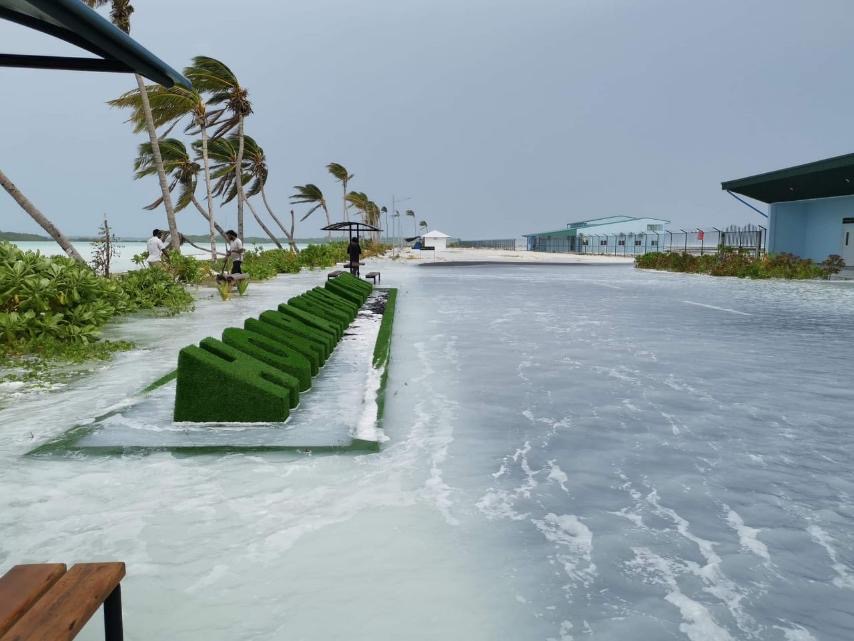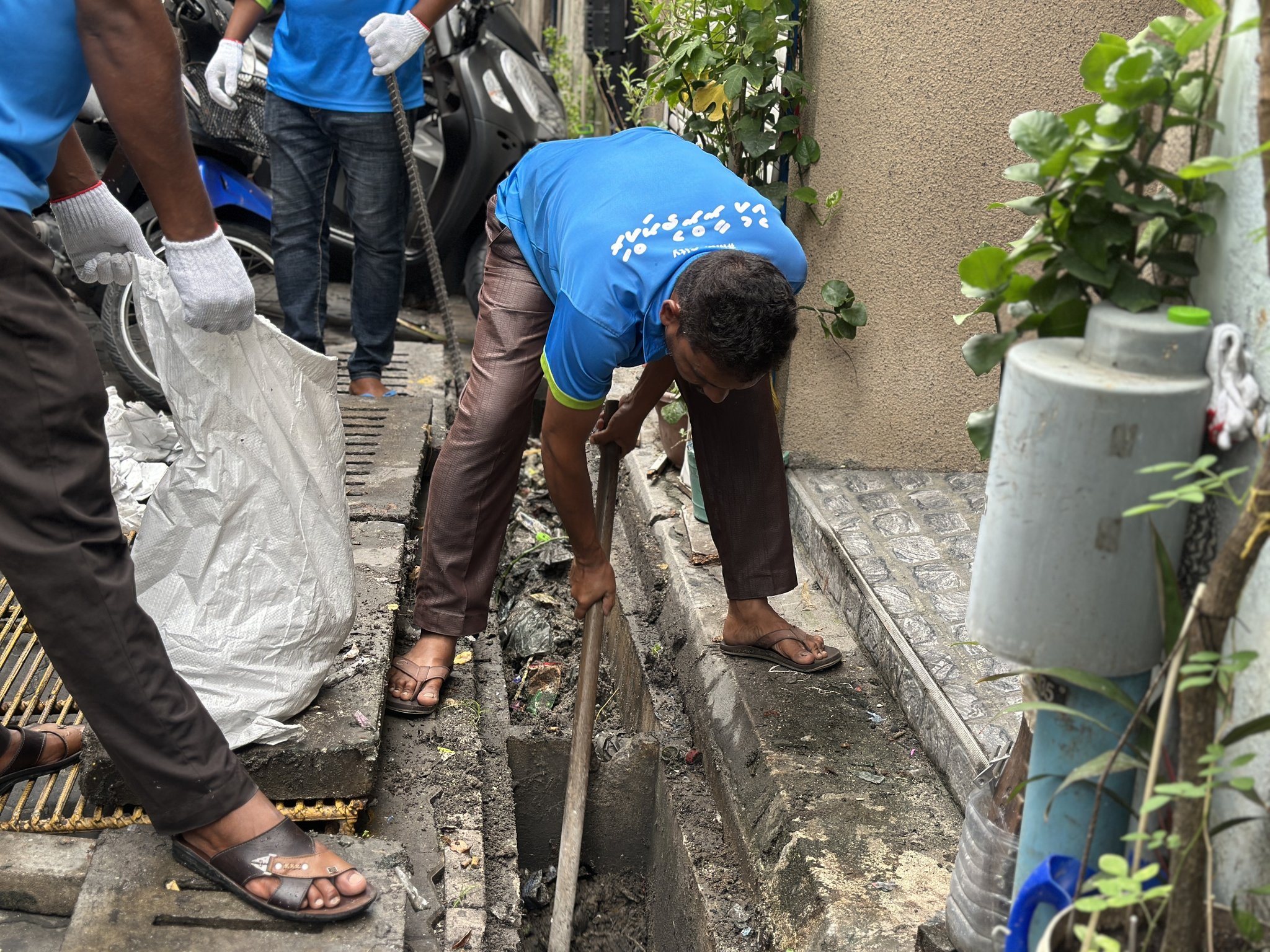What Is Surface Water Flooding?
Surface water flooding happens when heavy rain falls faster than it can drain away. The water stays on the ground surface and flows across roads, yards, or open areas before it can soak into the ground or reach drainage outlets.
In the Maldives, where the land is very flat and close to sea level, even short periods of heavy rain can cause widespread flooding. When stormwater drains are blocked, when tides are high, or when the soil is already saturated, the water has nowhere to go. It begins to collect in homes, streets, and public spaces, sometimes lasting for hours or days.
Surface water flooding is the most common type of flood in the Maldives. Its impacts on people, homes, and local businesses can be severe, especially when rainfall events are becoming more frequent and intense due to climate change.

A photo of Hoarafushi Island flooded due to heavy rain in May 2021.
Why Surface Water Flooding Happens in the Maldives
Several factors combine to make the Maldives highly prone to surface water flooding:
Heavy rainstorms: As the climate changes, intense rainfall is happening more often, overwhelming local drainage systems.
Poor drainage: Many islands have open drains or soak pits that easily get blocked by litter, sand, or vegetation.
Ground conditions:
In mushy or low-lying areas, water cannot drain and remains stagnant.
In dry, baked soils, caused by high heat, rain cannot soak in easily.
Urbanization: Development and road paving increase impermeable surfaces, so rainwater can no longer absorb into the ground.
Geography: Flat terrain means there is little slope for runoff. Some islands have slightly raised sides, trapping water in the center.
Waste accumulation: Poor waste management blocks stormwater paths and worsens flooding during heavy rain.
High tides: When sea levels are high, drainage outlets cannot discharge properly, causing backflow and waterlogging.
These combined factors mean that even moderate rain can quickly turn into a serious flood on many islands.
Flood Alert Levels in the Maldives
The Maldives Meteorological Service (MET) issues flood alerts based on rainfall intensity and observed impacts. These color-coded levels help communities and visitors know when to act.
⚪ Alert White: Information
50mm rain in 1 hour or 80mm in 6 hours.
Minor flooding possible.
Stay informed and check local drains.
🟡 Alert Yellow: Advisory
70mm in 1 hour or 100mm in 6 hours.
Localized flooding likely.
Avoid low-lying areas and prepare to protect belongings.
🟠 Alert Orange: Warning
90mm in 1 hour or 120mm in 6 hours.
Flooding in multiple areas expected.
Move to safe areas and avoid flooded roads.
🔴 Alert Red: Severe Warning
180mm in 6 hours.
Widespread flooding expected.
Stay indoors or move to shelters.
Follow official advice.
Warning Signs
Surface water flooding often gives visible early clues. Watch for:
• Rainfall that continues heavily for more than an hour.
• Water beginning to pool around buildings, drains, or roads.
• Drains overflowing or water flowing in the wrong direction.
• Rising water levels in wells, courtyards, or streets.
If you see these signs, take action early to protect your property and family.
Flood Precautionary actions
Before a Flood: Get Ready
Clean the drains regularly. Keep household and community drainage systems free from sand, leaves, and waste.
Use sandbags or barriers at doorways to prevent water from entering homes.
Move household items and appliances such as washing machines or fridges to higher levels if flooding is expected.
Relocate food and valuables from floor level to safer places.
Check your home insurance to make sure it covers flood damage.
Stay informed by following MET and NDMA updates on rainfall and alerts.
Communities can reduce flood risk by organizing clean-up drives before the monsoon season and reporting drainage blockages to local councils.

Male’ City Council workers cleaning clogged drainage systems in Male’ City to prevent surface water flooding. Source: Male’ City Council.
During a Flood: Stay Safe
Follow advice from authorities. Listen to your council, NDMA, or MET updates.
Avoid walking or driving through floodwater. It may be deeper than it looks or hide dangerous objects.
If you must move through water, wear rubber boots or waterproof footwear.
Turn off electricity if water starts to enter your home.
Be ready to evacuate if instructed. Move to a higher, dry place or upper floors if safe to do so.
For tourists, resorts will provide specific instructions — follow staff directions immediately and avoid flooded areas or beach paths.
After a Flood: Clean Up Safely
Once water levels go down, it’s important to clean carefully and stay alert for health risks.
Wait for official clearance from local authorities before returning to flooded areas.
Check for hazards such as broken glass, sharp objects, or live wires.
Clean and disinfect floors and surfaces touched by floodwater.
Use gloves and boots during cleanup.
Dispose of damaged food and goods safely.
Report damages to local councils or NDMA for assistance.
Floodwater can contain waste or sewage, so keep children away from affected areas until they are cleaned and disinfected.
Reducing Future Flood Risks
Building resilience means preventing future floods from causing the same damage again.
Keep drains, soak pits, and road gutters clean all year round.
Avoid dumping waste or sand near drainage outlets.
Design homes slightly elevated from ground level.
Plant grass or vegetation to help absorb rainwater.
Work with local councils to improve drainage plans.
Ensure new construction projects leave enough space for water flow.
By maintaining good drainage and responsible land use, communities can reduce the impact of future heavy rains.
Stay Prepared, Stay Safe
Surface water flooding is a natural part of living in low-lying islands — but its damage can be prevented. By keeping drains clear, acting early, and helping one another, we can reduce the impact of floods and protect lives, homes, and livelihoods.
Be alert. Be prepared. Keep your island safe.